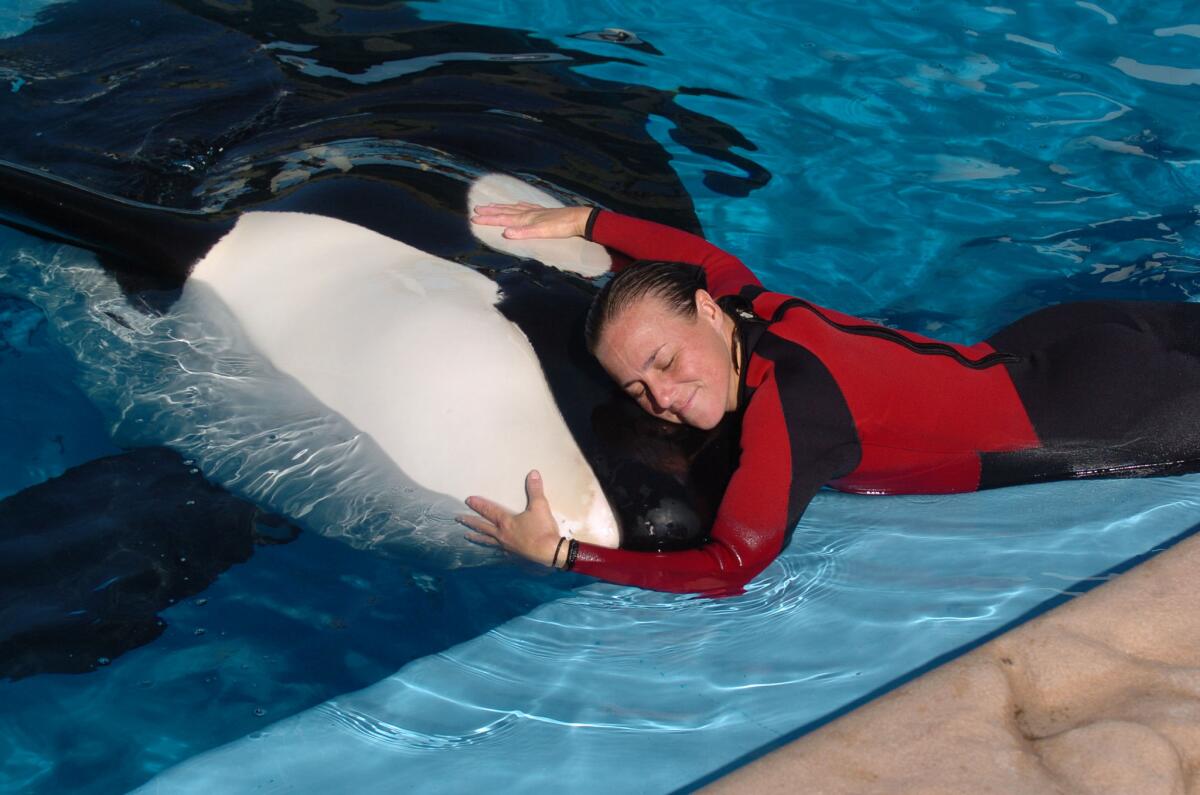Killer whales: Court weighs lifting ban on trainer-orca contact

In the latest skirmish in a years-long legal battle prompted by the death of a SeaWorld trainer in Florida, a federal appeals court heard arguments in a case challenging a ban on close contact between SeaWorld staff and killer whales.
In 2010 at the Orlando park, killer whale Tilikum snatched trainer Dawn Brancheau from a platform and thrashed her around underwater until she died. Federal workplace investigators later cited SeaWorld, saying trainers were exposed to hazards because they were allowed unprotected contact with the killer whales.
In the U.S. Court of Appeals for the D.C. Circuit on Tuesday, SeaWorld Entertainment’s attorney Eugene Scalia -- son of U.S. Supreme Court Justice Antonin Scalia -- took issue with the way a clause in the Occupational Safety and Health Act was applied to SeaWorld.
The General Safety Clause requires that employers provide a workplace that’s free from hazards that could cause death or serious physical harm to employees. However, as the plaintiffs argue in briefs filed with the court, the clause “cannot be used to force a company to change the very product that it offers to the public, and the business it is in.”
For SeaWorld, its business is close contact, Scalia argued. Close contact is defined as trainers being more than knee-deep in the water.
“SeaWorld exists to offer the opportunity to view that close interaction between whales and people. That is its product that it’s offering,” Scalia said in court.
For that reason, he argued, OSHA can’t prohibit SeaWorld from allowing such contact between trainers and whales.
According to a recording of the proceedings posted on the court’s website, Scalia told the three-judge panel: “It’s as if the federal government came in and told the NFL that close contact on the football field would have to end because, after all, more people are injured in the NFL on any given Sunday than were injured in the 22-year period that OSHA looked at in this case.”
Amy Tryon, an attorney representing the Department of Labor, argued that close contact posed a serious risk to trainers.
On Feb. 24, 2010, Brancheau, an experienced trainer, was snatched by Tilikum while she was rubbing his nose after a show, then dragged underwater and killed as audience members watched. Tilikum had been involved in two other deaths, including one at the water park in 1999.
“SeaWorld’s training program does not take the predatory instinct out of these animals,” Tryon said, according to the recording.
Collectively, the SeaWorld parks in Orlando, San Antonio and San Diego house the world’s largest collection of killer whales.
Tryon agreed that making the NFL switch to tag or touch football would likely put an entire industry out of business. However, she said close contact isn’t essential to SeaWorld’s product.
Since Brancheau’s death, SeaWorld has continued to offer killer whale shows every day in all three SeaWorld parks, but trainers do not enter the water beyond knee-level, SeaWorld Entertainment communications vice president told the Los Angeles Times.
That change at SeaWorld, Tryon argued, proves that the ban on close contact does not run the risk of shutting down an industry. The Times reported in August that park attendance was down 6% in the first half of 2013.
“It has not put SeaWorld out of business,” she said.
The treatment of orcas in captivity has received increased attention in recent months with the release of the documentary “Blackfish,” which critically tracks the years Tilikum has spent performing in aquatic parks.
Arguments before the judges concluded Tuesday. A ruling will likely be reached in a few months.
ALSO:
What’s next in racially charged Renisha McBride shooting case?
Supreme Court rejects Oklahoma abortion regulation a second time
N.C. man arrested on allegations of attempting to join terrorist group
Twitter: @skarlamangla
More to Read
Sign up for Essential California
The most important California stories and recommendations in your inbox every morning.
You may occasionally receive promotional content from the Los Angeles Times.











